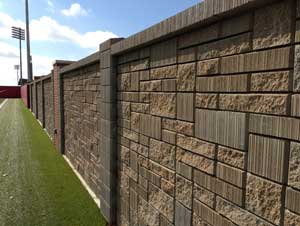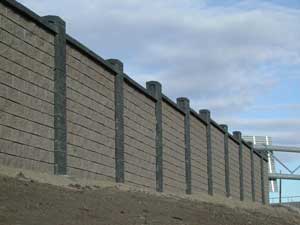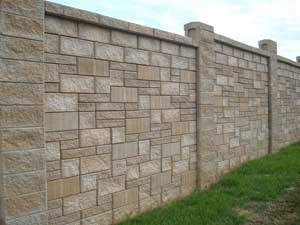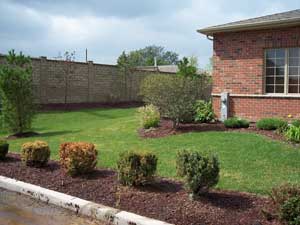Where to Begin?

Privacy Fence
The first things to consider when designing an AB Fence is what is the desired maximum height and what are the wind pressures the fence needs to resist. The resulting design will provide the maximum post spacing for the project. Once the maximum post spacing is determined, it can be used to optimize the plan layout provided by the site designer.
The strength of the AB Fence systems is its ability of resist wind loads. These wind loads are determined based on the average wind speeds in the project area and the exposure characteristics of the surrounding area. Average wind speeds will depend on where the project is and what the local weather conditions are.
Wind Speeds
Wind is one of the significant forces of nature and must be considered in the design of the AB Fence System. For years meteorologist have accurately measured and recorded wind speeds. By analyzing this data the average wind speed for a given return period can be obtained for a region. The return period refers to the most probable average wind speed that will be equaled or exceeded once during a period of time compared to the life of the fence. The shorter the period of time the less the wind speeds. For example, a 10-year average wind speed will be much less than a 50-year average. Allan Block uses a 50 year return period for the AB Fence Design Methodology.
See the Fence Design Tables for examples of the design criteria for AB Fence projects.
Wind Pressures
Since wind is air in motion the resulting wind pressures are related to its kinetic energy and can be determined by the following standard expression:
q = ½ ρV² where, q is pressure in lb/ft² or N/m² (pascal) ρ is an average air density - 0.0809 lb/ft³ or 1.29 kg/m³ and V is the average wind speed in ft/sec or m/sec
This is called the stagnation pressure (q) because it refers to the maximum positive increase over ambient pressure that can be exerted on the fence by any given wind speed. Stagnation pressure is the basic, nonfactored pressure to which all other pressures are referred to and are usually referenced in regional building codes.

Sound Barrier Fence
Wind pressures exerted on the AB Fence depend not only on the speed of the wind, but on the interaction of exposure effects as well. Structures such as buildings, landscape features, street corridors and open areas such as fields, parks, parking lots and bodies of water all significantly affect the wind patterns and need to be considered. An exposure category that adequately reflects the characteristics of ground surface irregularities is determined for the site. Open terrain allows for the maximum exposure, while structures found in developed or urban areas have minimum exposure.
Exposure
Described below are the three exposure categories used in the designs of the AB Fence:
- Exposure B:
Urban and suburban areas, wooded areas, or other terrain with numerous closely spaced obstructions having the size of a single family dwelling or larger. - Exposure C:
Open terrain that includes flat open country, grasslands, and bodies of water under 1 mile (1.6 km) in width. - Exposure D:
The most severe exposure with flat, unobstructed areas and bodies of water over 1 mile (1.6 km) in width. Exposure D extends inland from the shoreline ¼-mile (0.4 km).
Engineering Methodology
| AB Pressure Coefficients (Ce) | ||
| Exposure | H<12 ft (3.7m) Pressure Coefficient |
H>12 ft (3.7m) Pressure Coefficient |
| B | 0.68 | 0.85 |
| C | 0.9 | 1.2 |
| D | 1.2 | 1.5 |
| The coefficients are listed by the exposure category, but are based on general site topography, structure height and structural importance as well. | ||
Design calculations have also included site topography and structural importance when factoring wind pressures on a structure. The table shown here provides the AB Pressure Coefficients. The coefficients are listed by the exposure category, but are based on general site topography, structure height and structural importance as well.
For the AB Fence designs, the wind pressure is based on the 50-year average wind speed (return period) and should be multiplied by the appropriate pressure coefficient. This factored pressure is then used in the design calculations, which is based on simple beam theory and basic engineering principles.
Design Calculations
This example shows typical design calculations for the AB Fence. For definitions of variables,see the AB Fence Engineering Manual for terminology.
Analyze an AB Fence with the following characteristics:
Fence Height: H = 6 ft (1.83 m) = 9 courses
SoilType: Clay SD = 100 psf (4.8 kN/m²)
ExposureType: B
Wind Speed:V = 80 mph (35.8 m/s)
Pressure Coefficient (Ce): 0.68

Allan Block fence with pattern
To see the full details of this example, see the Fence Design Examples
Seismic
Another potential loading condition is seismic. In all relative building codes the effects from seismic and the effect from wind are never combined. This means that for seismic to control the design, its effects must be greater than those of wind. Wind is a nearly constant variable that makes it much more critical than seismic events that are vary localized. Therefore, this manual will concentrate on the effects of wind. For seismic loadings, refer to your local building codes.
Design the Layout
The AB Fence System is similar to a traditional wooden fence in that the panels are supported by the posts. The posts are anchored in place with concrete below grade. Therefore, the final support to the AB Fence or the wooden fence is done by the soil around the pile footings.
The advantage of the AB Fence System when compared to other concrete systems is how the panels slide into the AB Fence posts, but are still allowed to move independently. This flexibility eliminates the requirement of constructing the panels below the local frost limits, which keeps the installation costs down.
Knowing the desired location of the fence is your starting point. For estimating purposes, use the Design Tables. Remember that the final design should come from a local engineer. Next, finalize the fence height and panel spacing. The AB Fence Posts must be placed at set locations to allow for the AB Fence Panel Blocks to fit between them properly without unnecessary cutting of blocks.
For the approximate post spacing and associated number of panel blocks, refer to the Fence Post Spacing Table. To accomodate a projects specific lengths, use a combination of two or three different post spacings. Using the shorter post spacing may not reduce the pile depth. Final pile locations will be determined during the installation process.
Determining the Number of Panels

Privacy Fence
The best way to explain this is to work through an example. Our sample project will be 160 ft (49 m) long with a desired height of 8 ft (2.4 m) in clay soil.
Using the Design Tables we determined:
- Exposure B with 80 mph (35.8 m/s) winds
- Maximum Post Spacing: 15.3 ft (4.7 m) or 9.5 blocks per panel
However with our project this would give us a total of 10.4 panels (160 ft divided by 15.3 ft), which is 10 panels with a span of 9.5 blocks and 1 panel with 4 blocks. This will work, but will not look completely uniform. An option may be to use 10 panels with a span of 9 blocks and one panel with a span of 9.5 blocks (see graphic above). See the Fence Post Spacing Table for more post spacing options. If there will be corners in the project, each section will need to be figured independently, see fence corner installation for more information.

